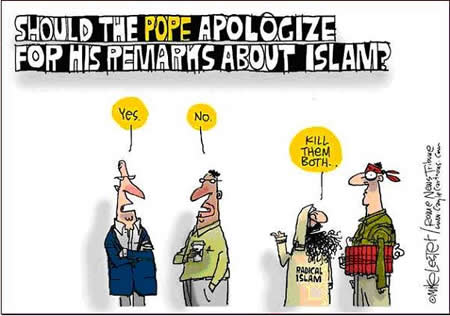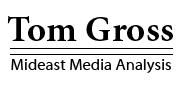Islamic militancy
THE cartoons and photographs below are divided into four categories.
First, there is the murder of a moderate Muslim by Islamic Jihad in the West Bank city of Jenin. Such murders, which are commonplace, are rarely reported on in the Western media; indeed some prominent Western newspapers even go so far as to include the victims in statistical tallies of “Palestinians killed by Israel”.
The second set of cartoons and photographs below concern the dispute over cartoons of Mohammed published in a single edition of Jyllands Posten, a newspaper which virtually no one outside Denmark had heard of before the dispute. For more context on this issue, please see “To be or not to be.”
The third set provide a glimpse of the worldwide violent reaction by extremist Muslims to one small passage from a lengthy speech made in German in September 2006 by Pope Benedict XVI, in which the Pope quoted a 14th-century Byzantine emperor. The attacks on the Pope and Christians in various countries continued even after the Pope apologized.
The final group show the increasing radicalism of some Muslims, including
those in the U.S. Again, these kinds of photos are either not published
at all by influential Western liberal media such as The New York Times,
or significantly downplayed.
-- Tom Gross
Click here for more Cartoons
from the Arab world
Click here for Anti-Israel
cartoons
How moderate Muslims are treated
Jenin, Sunday, August 13, 2006: A moderate Muslim who wanted to make peace with Israel and the United States is murdered by members of the Palestinian Islamic Jihad group.
The execution, for which Islamic Jihad proudly claimed responsibility on its website, took place in a public square in front of a celebratory crowd of hundreds. In the second, third and fourth photos below, some of the crowd can be seen taking pictures of the murdered man with their mobile phones, propping up his head to get a better angle, while others stomped on him.




The Danish Cartoons

Above: The cartoons of Mohammed as they originally appeared
in the Danish newspaper, Jyllands Posten, in September 2005.

Six months later, after Islamic leaders deliberately stirred up their followers to violence over the Danish cartoons, mass demonstrations resulting in hundreds of deaths swept the globe. Above: Iranian protesters burn Danish and French flags in front of the Austrian Embassy in Iran in February 2006.

Muslim protesters stage a rally against the Danish newspaper cartoons in front of The New Straits Times office in Kuala Lumpur, February 24, 2006. The New Straits Times angered many Muslim groups in Malaysia by publishing the syndicated “Non Sequitur” cartoon strip about the controversy. Even though the “Non Sequitur” cartoon did not show the prophet, the Malaysian government asked the newspaper to give reasons why it should not be shut down. Another Malaysian newspaper, The Sarawak Tribune, which had been publishing for 60 years, was permanently shut down because it criticized those protesting against the cartoons.

A demonstration against the Danish cartoons, London, February 2006. So intimidated by Muslim extremist threats were the normally robust British media, that not one British paper or magazine reproduced the Danish cartoons even to accompany articles explaining what the controversy was about.


Photos of Muslims expressing anger at the Danish cartoons (like the ones above from Yahoo news, February 16, 2006) were often deliberately not reproduced in the mainstream liberal Western media.

These were the 12 Danish cartoons that led to so much outrage. Several of the cartoonists went into hiding following widespread death threats, not only by European Muslims, but by Muslim government officials. A minister in the Uttar Pradesh state government announced a cash reward of the equivalent of $11 million for anyone who beheaded one of the Danish cartoonists.

It is hard for many non-Muslims to understand what was so offensive about some of the Danish cartoons, like the one above. In Germany, for example, a student from Pakistan, entered the offices of Die Welt newspaper, armed with a large knife. He admitted to trying to kill the editor for reprinting the Mohammed cartoons.
Attached below are five unfavorable or irreverent representations and pictures about Mohammed that failed to elicit the same kind of anger, since Islamic fundamentalists didn’t choose to exploit them.

From Nouveau Tintin comic book, May 17, 1977 edition.

This early Renaissance fresco in Bologna’s Church of San Petronio, created by Giovanni da Modena, depicts Mohammed being tortured in Hell (and could obviously be offensive to some people).

In 2002, this political cartoonist published a drawing
of Mohammed driving a truck with a nuclear bomb.

The television cartoon South Park aired an episode on July 4, 2001 called Super Best Friends. In it, the founders of the world’s great religions – including Mohammed – team up for super-hero action. Mohammed (seen here, above) is depicted repeatedly throughout the show.

Mohammed by Salvador Dalí.
The pictorial portrayal of Mohammed is not forbidden in the Koran, but only in relatively recent interpretations of Sharia law. Here are some examples of Muslims themselves portraying Mohammed. Such depictions were commonplace until the modern growth of Islamic fundamentalism.

Birth of Mohammed (16th century Ottoman illustration of the Siyer-i Nebi).

Miniature of Mohammed re-dedicating the Black Stone at the Kaaba. From Jami Al-Tawarikh (“The Universal History” written by Rashid Al-Din); illustrated in Tabriz, Persia, c. 1315 during the rule of the Sunni Arab Muzaffarid dynasty.

A 16th century Persian miniature painting celebrating
Mohammed’s ascent into the Heavens.

Mohammed advancing on Mecca, with the angels Gabriel,
Michael, Israfil and Azrail (16th century Ottoman illustration.)
The Pope’s Remarks

After Muslims objected to one small passage from a lengthy speech made in German in September 2006, by Pope Benedict XVI, in which the Pope quoted a 14th-century Byzantine emperor, worldwide Muslim protests began. Some were physically violent, resulting in a number of Christians being murdered, including a nun in Somalia. Others were verbally abusive, such as this one in London targeting worshippers leaving services at London’s Roman Catholic Westminster Cathedral. They were greeted by demonstrators chanting slogans such as “Pope Benedict go to Hell” and “Pope Benedict you will pay, the Mujahadeen are on their way.”

More extremist demonstrators outside London’s Westminster Cathedral.

In the government controlled-media of the Palestinian Authority, there was much incitement against the Pope. Above, the Pope portrayed as a Nazi in the Palestinian newspaper, Al-Risala, September 18, 2006.

Following incitement from the media, at least five churches in Palestinian Authority controlled areas were attacked in “retaliation” for the Pope’s comments. Above, a church burns in Nablus, September 2006.

Some Muslim extremists linked the Pope’s comments to the Danish cartoons of Mohammed, as a warning that Muslim fundamentalists would not tolerate any criticism whatsoever. Above a cartoon from the Jordanian website, “mahjoob,” shows the Pope attached to one of the Danish Mohammed cartoons.
The speech bubble above the Pope says (in Arabic): “This is not my opinion, but a quotation only.” This was a reference to the Pope’s apology, which many Muslims did not accept. The Pope had said he was “deeply sorry” and added “these words were in fact a quotation from a medieval text which do not in any way express my personal thought.”
Cartoonists stand up for the Pope
Many commentators and cartoonists in the mainstream Western media shied away from taking a critical look at the extraordinary double standards of the Islamic world. Perhaps they were intimidated. Perhaps they sympathized with the extremists. Or perhaps they were just too busy demonizing Israel and the U.S. Below are a few who did cast a critical eye. The first cartoon is from the newspaper, The Australian (September 17, 2006). The rest are from the U.S.







The advance of fundamentalist Islam

Terror supporters at a pro-Hizbullah demonstration in New York City, Saturday, July 22, 2006. This was a rare example of Reuters publishing a photograph of such demonstrations, but note the blandness of the Reuters caption below, which completely ignores the hate symbols and proclamations of Islamic supremacism in their own photo:
Supporters of Lebanon protest outside the Israeli consulate in New York, July 18, 2006. REUTERS/Chip East (UNITED STATES).

Demonstrators from The “Islamic Thinkers Society” in New York City
call for Israel to be destroyed by a nuclear bomb (Saturday, July 22,
2006.)

Extremist British Muslims express their views, September 2006.

Extremist British Muslims express their views, February 2006.

In October 2006, Aishah Azmi, a 24-year-old teacher, was suspended by Headfield Church of England Junior School in West Yorkshire, England, after she insisted on wearing a full-face veil in lessons. She had been asked to remove the veil after pupils found it hard to understand her during English language classes. When Azmi had been interviewed for the job she had not worn a veil, but once she was employed she refused to lower it so that her mouth was uncovered. Her suspension by the school, which has 529 pupils aged seven to 11, provoked outrage from some fundamentalist Muslims and their non-Muslim sympathizers.

Virtually no demonstrations have been held in Western countries protesting the murder, torture, mutilation and abuse of rights that have occurred in Muslim countries. Above, a boy displays the hands of a man “punished” by the Taliban.

Muslim fundamentalists, looking like the Ku Klux Klan, parade on motorbike through the Indonesian capital Jakarta on their way to a pro-suicide bomb rally on August 1, 2006.

A protester from the Islamic Defender Front (FPI) wears a mock suicide bomb during a rally held in front of the U.N. office in the Indonesian capital Jakarta on August 1, 2006.



This Palestinian grandmother, Fatma Omar An-Najar, 57, proudly blew herself up alongside Israeli Jews in November 2006. The first image above was released by Hamas, the group to which she belonged. The second image is from a video played on Palestinian TV of her reading her “will” before leaving for the attack. She said she wanted to kill as many Jews as possible and urged her nine children and 41 grandchildren to do the same. Indeed many Palestinian children wish to follow in her footsteps. Here is the transcript of two 11-year-old girls, Walla and Yussra, being interviewed on Palestinian Authority TV: Interviewer: You described Shahada (martyrdom) as something beautiful. Do you think it is beautiful? Walla: Shahada is a very beautiful thing. Everyone yearns for Shahada. What could be better than going to Paradise? Interviewer: What is better, peace and full rights for the Palestinian people or Shahada? Walla: Shahada. I will achieve my rights after becoming a Shahid (martyr). We won't stay children forever. Interviewer: Okay, Yussra, would you agree with that? Yussra: Of course. It is a sweet thing. We don't want this world, we want the afterlife. We benefit not from this life but from the afterlife… |

